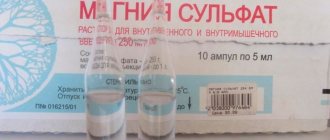Home>Articles>Magnesia as a hangover cure
quick menu (hide)
- What is the drug
- Features of the action
- Using magnesium for a hangover
- Compatibility of alcohol and magnesia
- conclusions
There is hardly an adult who has never experienced a hangover. At the first stages of drinking alcohol, when a person had not yet figured out when he had enough, an unpleasant state arose in every drinker. Over time, this goes away, because the person tries not to exceed the norm. However, there are cases when it is still possible not to calculate the dose, and not everyone knows how to do this.
A hangover is a very unpleasant and sometimes truly painful condition, which is the result of too much alcohol in the blood. Alcohol, after being processed by the body, breaks down into individual components. One of the breakdown products is acetaldehyde, which causes a hangover.
To relieve unpleasant sensations, many different means are used, ranging from long-known “folk” ones to the most modern achievements of pharmacology. One of the most popular drugs among the population is Magnesia, although in fact the drug is not intended to eliminate withdrawal symptoms. The medication is an excellent laxative. What is its compatibility with alcohol? How does Magnesia help with a hangover? Let's figure it out further.
Properties and features of the drug
Drinking excessive amounts of alcohol inevitably leads to a hangover - the next morning after a wild party, a person experiences a number of extremely unpleasant symptoms. Poisoning with ethanol and its metabolites provokes headache, nausea, dizziness, and a state of general weakness and weakness . To get rid of hangover symptoms, patients try to use a variety of “folk” remedies and medications. One of the most popular among them is magnesium - magnesium sulfate, which has a multifaceted effect on the body.
Magnesia or magnesium sulfate is a magnesium sulfuric acid salt, also called Epsom salt. This is a powder for preparing a suspension ; it can also be purchased in pharmacies in ampoules, ready for injection. Intramuscular or intravenous administration provides the greatest effectiveness in eliminating hangover symptoms.
This drug has primarily a laxative and choleretic effect, which allows it to be used as a remedy for the treatment of severe poisoning. It is used for heavy metal poisoning Such properties have made it possible to use the remedy for treating hangovers - it allows you to quickly rid the body of ethanol breakdown products and improve your well-being.
The effect of the drug on the body depends on the method of administration:
Oral administration (by mouth) allows you to obtain a pronounced laxative effect within 2-3 hours.
Cleansing the intestines helps reduce the symptoms of poisoning. Intramuscular and intravenous administration provides anticonvulsant and sedative effects. Administration of the medicine by injection should be slow, this allows the effect to last up to 4 hours. With intravenous administration, the result can be obtained as quickly as possible, but the drug will act for no more than half an hour.
Drip administration. Magnesia is administered using a dropper in case of severe alcohol poisoning; it can be used as part of a complex of remedies for withdrawal from heavy drinking. Only a doctor should be involved in setting up an IV and selecting medications; the medication is gradually administered over an hour.
Taking the drug is incompatible with drinking alcohol.
In this case, there will be an increased negative impact, and serious health problems are possible in the future. Application requires a complete abstinence from alcohol - this will make it possible to quickly get rid of a hangover and restore normal well-being.
What conclusions can be drawn
In fact, the product does an excellent job of serving its purpose. As reviews of Magnesia for a hangover testify, it perfectly relieves all symptoms of withdrawal symptoms. This occurs due to the rapid removal of all toxic substances formed after the breakdown of ethyl alcohol, which helps all body systems return to normal much faster.
Magnesia can be taken at the same time as drinking alcohol, but this should be done with extreme caution, and the correct solution would be to avoid such phenomena. Doctors' recommendations should not be ignored, and before using the drug it is recommended to consult a specialized doctor.
How does magnesium work for a hangover?
One of the reasons for a severe hangover is a violation of the water-salt balance: the body loses moisture, as well as beneficial salts, resulting in metabolic disruption. A lack of magnesium leads to migraine , sleep disturbances, insomnia, muscle spasms, and gastrointestinal diseases. With ethanol poisoning, all these unpleasant symptoms only intensify, and your health further worsens due to intoxication. Taking it helps eliminate magnesium deficiency and quickly eliminate the symptoms of poisoning.
Magnesia is used for hangovers , as it has the following set of properties:
Laxative and cleansing effect. The drug frees the body from alcohol and heavy, poorly digestible food, which often accompanies heavy libations.
Calming effect. Replenishing the deficiency of magnesium reduces feelings of anxiety, eliminates restlessness, and has a hypnotic effect.
Diuretic effect. The product helps relieve tissue from excess fluid, swelling and a feeling of heaviness go away.
Anticonvulsant action. The risk of convulsions and muscle spasms is reduced, tremors - hand trembling after severe alcohol poisoning - disappear.
Protection of the heart and blood vessels. The drug prevents tachycardia and heart rhythm disturbances, reducing the risk of complications of existing heart diseases. Blood pressure is reduced and a hypertensive crisis is prevented.
Restoration of strength. Supporting the functioning of the nervous system helps eliminate the feeling of lethargy and weakness; a person recovers much faster after a noisy feast with an abundance of alcohol.
Taking magnesium makes it possible to get rid of a whole complex of unpleasant hangover symptoms and quickly return to normal life. However, like any other medicine, it has its contraindications, so it is not recommended to use magnesia frequently and uncontrollably. To get over a hangover safely, it is recommended to call a narcologist to your home.
Compound
The product contains magnesium amino acid chelate and B vitamins based on Inulin.
1 tablet corresponds to 100% of the daily requirement for the following components:
- magnesium (chelate) 350 mg;
- vitamin B1 1.4 mg;
- vitamin B3 18.3 mg;
- vitamin B6 2.2 mg;
- inulin 199 mg.
How to take magnesium orally for a hangover?
In case of one-time ethanol poisoning as a result of drinking large amounts of alcohol, it is recommended to take the drug orally. Magnesium sulfate powder is purchased at the pharmacy, after which you need to prepare a 10% solution. The contents of one sachet are dissolved in 100 ml of boiled water; 1/10 of the resulting solution is used for a single dose. The powder is taken up to three times a day with an interval of 40-50 minutes.
When taken orally, results can be felt within 30 minutes. The solution will act as follows:
The headache will begin to disappear. Taking magnesium sulfate can even cope with acute migraine attacks due to alcohol intoxication.
The feeling of anxiety and insomnia will go away. A person gets the opportunity to sleep peacefully to restore strength.
The diuretic effect will increase, which will lead to the gradual disappearance of edema.
Heart rate normalizes. The patient gets rid of tachycardia, which also improves well-being and normalizes mental state.
Symptoms of intoxication disappear. As a result, a person feels a rapid improvement in well-being, and the symptoms of a hangover disappear.
Maintaining the correct dosage helps avoid harm to the body. Only a doctor should administer the drug by drip and injection; such procedures require caution and practiced skill.
Features of the action
The effect of using the drug Magnesia for a hangover in ampoules manifests itself most quickly. In this case, it is administered by injection. This allows you to quickly normalize your heartbeat, relieve headaches and remove swelling. The sedative effect of magnesium sulfate blocks the development of increased anxiety, irritability, sudden changes in mood, feelings of guilt, and depression.
An injection of Magnesia for a hangover allows you to quickly restore the magnesium content in the body and normalize the functioning of the cardiovascular system. The choleretic effect of the drug allows you to limit the load on the liver and gallbladder.
Injection of magnesium
When a narcologist is called to your home due to an acute hangover, therapy is selected personally. The specialist assesses the patient’s condition and the severity of the symptoms of intoxication; for this, he examines and interviews the patient himself and his relatives. After this, the specialist determines the optimal dosage taking into account the patient’s age, existing symptoms, and severity of the condition.
For intramuscular administration, magnesia is dissolved in novocaine or lidocaine - painkillers help reduce the discomfort of the injection, since it is quite “heavy” for the patient. The dosage is selected based on standard recommendations:
To eliminate edema and normalize the water-salt balance, 5-10 ml of solution is injected intramuscularly.
In case of magnesium deficiency resulting from an acute hangover, the patient is prescribed intramuscular injections of magnesium sulfate, 4 ml of a 25% solution. Injections are given at intervals of every 6 hours. In severe forms of magnesium deficiency due to chronic alcoholism, the deficiency is replenished with the help of droppers already in a hospital setting, the dosage is calculated by a doctor.
If the drug is prescribed to correct heart rhythm, 4-8 ml of solution is injected intramuscularly.
For headaches resulting from a hangover, 5-10 ml of a 25% solution of magnesium sulfate with intramuscular administration can be prescribed.
It is not recommended to carry out injection therapy without the consent of a doctor. A severe hangover can provoke an exacerbation of existing chronic diseases, so you can take any medications only under the supervision of a specialist. This is especially important for older people over 55 years of age.
Use of magnesium in obstetrics
Magnesium is one of the vital microelements, the fourth most abundant cation in the body and is found mainly in bone, muscle and nerve tissues. Less than 1% of the total magnesium in the body is found in plasma and red blood cells. About 60% of magnesium contained in plasma is in an ionized state, and the rest is associated with albumin or complexed with ions - mainly citrate and phosphate [15].
Magnesium is involved in the regulation of metabolic processes in the body: in energy (complexation with ATP and activation of ATPases, oxidative phosphorylation, glycolysis), plastic (synthesis of protein, lipids, nucleic acids) and electrolyte metabolism. In addition, it is a cofactor for many enzymes, acts as a calcium antagonist, and takes part in the relaxation of muscle fibers other than the heart muscle. Magnesium also reduces platelet aggregation ability, maintains normal transmembrane potential in electrically excitable tissues, and affects the endothelium, which plays a key role in vascular homeostasis, in particular, through the production of nitric oxide and participation in the control of platelet aggregation. It has been proven that magnesium ion deficiency increases the activity of thromboxane A2, which is accompanied by damage to the vascular wall. The protective effect of magnesium on neurons is manifested by inhibition of calcium channels and antagonism with the N-methyl-D-aspartic acid receptor [15].
Numerous units of measurement of magnesium dose are used in foreign literature (table). The daily requirement for magnesium is 350 mg for men and 280 mg for women and increases during pregnancy and lactation by at least one and a half times (360–400 mg/day).
During breastfeeding, for the normal development of the growing body of a newborn, the concentration of magnesium in breast milk should be 30–40 mg/l [15]. The richest magnesium crops are grains, legumes, greens, nuts, and chocolate. The absorption of magnesium from food products is 30–35%.
Regulation of magnesium levels depends on renal excretion. Excess plasma calcium and magnesium activates the calcium receptor in the kidneys and thereby increases diuresis to remove excess of both ions. Thus, magnesium leads to an increase in its own clearance with normal renal function.
The generally accepted plasma magnesium level is 0.75–1.0 mmol/L. However, magnesium is an intracellular ion, so its deficiency in the body can be present even with normal and elevated plasma magnesium levels [15].
It was found that magnesium levels decrease during pregnancy, reaching a minimum value at the end of the first trimester, partly due to dilution and release into the extracellular space and partly due to absolute magnesium deficiency. Magnesium deficiency has numerous consequences, including chronic fatigue, delirium, weakness and seizures, impaired glucose metabolism, a variety of arrhythmias, vascular disorders and disturbances of electrolyte metabolism, especially potassium. The immediate manifestations of magnesium deficiency most often include a rapidly developing lack of magnesium in the body, which leads to a state of increased nervous excitability of the cell. Clinically, it manifests itself as muscle twitching and cramps, most often in the calf muscles, which is a common problem during pregnancy. Arrhythmia in pregnant women is also often associated with magnesium deficiency. Magnesium deficiency during pregnancy increases the risk of insulin resistance and diabetes. Magnesium deficiency during pregnancy can lead to the development of placental insufficiency, preeclampsia due to spasm of the uterine arteries, and fetal growth restriction syndrome [15]. Magnesium also has a significant effect on the condition of connective tissue. During pregnancy, prolonged magnesium deficiency can provoke the development of stretch marks in the chest and abdomen in a woman during a period of rapid breast growth and an enlarged uterus. Childbirth in women with magnesium deficiency is more often complicated by perineal ruptures [5, 8].
In obstetrics, magnesium is used for two main purposes - as a tocolytic in the form of magnesium sulfate (or magnesium chloride in solutions for IM and IV infusions) and as replacement therapy for nutritional support and balanced diet. A rational, balanced diet is an essential basis for bearing a healthy fetus and giving birth to a healthy child.
In the absence of diseases of the gastrointestinal tract, eubiosis of the intestinal flora and the absence of genome polymorphisms associated with severe disorders of magnesium metabolism, the daily requirement for magnesium can be met with a balanced diet. The required amount is calculated based on the following indicator: 5 mg/kg/day. Some people need more magnesium due to significant losses. Children require 5 to 10 mg/kg/day; pregnant women (or nursing mothers) - 10–15 mg/kg/day; women with established magnesium deficiency also require 10–15 mg/kg/day. To select a diet, you should take into account the quantitative content of magnesium in food and its bioavailability. Thus, fresh vegetables, fruits, herbs (parsley, dill, green onions, etc.), and new crop nuts have the maximum concentration and activity of magnesium.
When preparing products for storage (drying, drying, canning, etc.), the concentration of magnesium decreases slightly, but its bioavailability drops sharply. It should be noted that magnesium deficiency is less common in summer and manifests itself more easily than in winter [7]. In the same type of product, the concentration of magnesium can vary significantly. Treatment with mineral water with magnesium ions and salts is of particular importance when preparing a dietary correction. Waters containing a significant amount of magnesium include “Batalinskaya” (Mg - 1.52 g/l), “Donat”, “Slovenia” (Mg - 1.26 g/l), water from the Lysogorsk well, “Pyatigorsk” (Mg - 0.65 g/l), water from the Kuka resort (well No. 27, Mg - 0.23 g/l), as well as Crimean Narzan and Kislovodsk Narzans. All other waters tend to have a very low magnesium content.
It should be noted that almost all vitamin and mineral complexes for pregnant women contain magnesium in low-access and poorly absorbed inorganic magnesium compounds. Recently proposed natural preparations for the correction of calcium and magnesium, obtained from animal bones and dolomite flour, oyster shells, shells, have not been sufficiently studied; there is no data on adequate purification of these preparations from harmful impurities, in particular from lead. And pregnant women should not use biologically active food supplements that do not have special recommendations for pregnant women. The prescription of magnesium preparations is a kind of replacement therapy and is carried out to correct its normal level and restore physiological processes in which magnesium takes an active part [7]. According to evidence-based medicine, intravenous use of magnesium sulfate in significant dosages or over a certain period of time can be very unsafe for both mother and child, so the issue of oral use of magnesium during pregnancy in the form of its various preparations remains relevant. The drugs of choice for the treatment of chronic magnesium deficiency and long-term prevention of pregnancy complications are oral dosage forms.
Nutritional correction with organic magnesium preparations is considered as an independent type of metabolic replacement therapy and is not mixed with the administration of high doses of magnesium sulfate for tocolytic purposes. To provide nutritional support in pregnant women and children with magnesium deficiency, various drugs have been developed. One of these drugs, widely used in obstetrics and gynecology, is a combination preparation of second-generation organic magnesium salt (lactate or pidolate) and vitamin B6 (pyridoxine). The first generation of magnesium preparations includes inorganic compositions: magnesium oxide, sulfate, chloride, etc.; the second - organic compounds: magnesium lactate, pidolate, orotate, glycinate, asparaginate, citrate, ascorbate [4, 7]. The bioavailability of organic magnesium salts is almost an order of magnitude higher than that of inorganic ones. Thus, the bioavailability of lactate, citrate and orotate is several times (5–6 times) higher than that of magnesium sulfate. Magnesium pidolate, citrate, gluconate, and aspartate also have a higher excretory capacity (in urine) than inorganic salts. Inorganic magnesium salts are less well tolerated and more often cause dyspeptic complications (diarrhea, vomiting, abdominal cramps). Organic magnesium salts are not only much better absorbed, but also easier to tolerate by patients and less likely to cause side effects from the digestive tract.
Treatment will be more effective if both magnesium and a magnesium fixative are administered simultaneously: B vitamins (B6 or B1); glycine, orotic acid. Pyridoxine is a good magnesium fixative because it improves the bioavailability of magnesium, magnesium forms well-absorbed complexes with the vitamin, in addition, vitamin B6 promotes the penetration of magnesium into cells and its preservation within cells. In addition, vitamin B6 and magnesium deficiencies are often combined with each other and have a similar clinical picture. It is also important that vitamin B6 forms a biocoordination bond with four magnesium atoms at once, which improves its bioavailability. In combination with magnesium, pyridoxine penetrates much better through the lipid layer of the membrane of any cells.
There are several galenic forms that are well absorbed in the intestines, released in the form of drugs: magnesium citrate, magnesium gluconate, magnesium orotate, magnesium thiosulfate, magnesium lactate and magnesium pidolate. The content of elemental magnesium in dosage forms varies. For example, magnesium gluconate, 0.5 g tablets contains 27 mg; magnesium citrate, effervescent tablets 0.15 g - 24.3 mg; magnesium orotate, tablets 0.5 g - 32.8 mg; magnesium thiosulfate, tablets 0.5 g - 49.7 mg; magnesium lactate – 48 mg [9].
According to a number of authors, undesirable manifestations of a combined deficiency of pyridoxine and magnesium appear already in the first trimester of pregnancy, and the administration of magnesium supplements to pregnant women, starting from the 4th–5th week of pregnancy, leads to a significant decrease in the level of spontaneous miscarriages [5–7]. Hypomagnesemia leads to fetal growth retardation due to insufficient transfer of magnesium from mother to fetus through the placenta, as well as due to impaired circulating plasma volume and the need for protein synthesis. In addition to protein deficiency, magnesium deficiency in the fetus leads to disruption of cellular energy metabolism and increased transmembrane metabolism.
Data from a meta-analysis of five placebo-controlled studies on the use of 2nd generation organic magnesium salts (magnesium lactate and magnesium citrate at a dose of 150 mg, 2 times a day) in pregnant women represent a high level of confidence. An objective and independent analysis has proven complete safety and high effectiveness for relieving calf muscle cramps (5 mmol in the morning and 10 mmol in the evening) [30].
A Cochrane study conducted to evaluate the effect of magnesium supplementation during pregnancy on pregnancy outcome and maternal and fetal health included 7 studies (2689 women). A pooled analysis of a cluster-design study found that magnesium supplementation before 25 weeks' gestation (compared with placebo) reduced the incidence of preterm birth (RR 0.73; 95% CI 0.57–0.94) and birth defects. low body weight (OR 0.67; 95% CI 0.46–0.96). Moreover, these women were less likely to be hospitalized (RR 0.66; 95% CI 0.49–0.89) and less likely to have antepartum hemorrhage (RR 0.38; 95% CI 0.16–0.90). In the remaining six studies, the differences in the effects of magnesium and placebo were not statistically significant. Therefore, the effectiveness of magnesium supplementation requires further investigation using studies with high quality design [2].
Another common use of magnesium in obstetrics is its use as a tocolytic. A number of studies of magnesium have shown advantages over sympathomimetics [16], but in other studies the results were opposite [28] or comparable [19] when comparing maternal and fetal risk and side effects. A number of studies have carried out a comparative assessment of the tocolytic activity of magnesium sulfate and nitric oxide donors (nitrates): the antispasmodic activity of magnesium turned out to be higher [23]. However, not all studies have proven the effectiveness of magnesium sulfate therapy in preventing preterm birth.
To evaluate the effectiveness and safety of magnesium sulfate in women with threatened preterm labor, a meta-analysis was conducted in the Cochrane database, analyzing 23 studies that included more than 2000 women. Only 9 studies met the criteria for high quality. The analysis revealed that magnesium sulfate does not slow down or prevent premature birth, but its use is associated with a lack of a positive effect on morbidity and an increase in neonatal mortality. It was concluded that further, larger and higher-quality studies are needed to seriously assess morbidity and mortality, as well as compare different drug administration regimens [1, 2, 22].
A special place in the list of indications for treatment with magnesium preparations is occupied by eclampsia - a severe multiple organ disorder of unknown etiology. The pathogenesis of eclampsia is complex, insufficiently studied and includes such links as endothelial dysfunction, impaired rheological properties of blood, and generalized vasoconstriction. The mechanisms of action of magnesium sulfate in eclampsia include suppression of the synthesis of thromboxane A2 and antagonism with calcium, leading to vascular dilatation, improvement of blood flow in the “mother-placenta-fetus” system and cerebral circulation [13, 18], another possible mechanism of action of magnesium sulfate is an increase in the level of calcitonin in the blood serum, which is reduced in women with preeclampsia [1, 14].
The effect of magnesium therapy in the treatment of eclampsia and a significant reduction in maternal mortality were shown in the famous randomized, placebo-controlled MAGPIE trial, in which magnesium treatment halved the risk of developing eclampsia in the absence of significant adverse reactions [20].
When comparing magnesium therapy and its effectiveness relative to anticonvulsants (diazepam, phenytoin, lytic cocktail), a large number of studies have demonstrated the effectiveness of magnesium sulfate in the prevention and treatment of eclampsia in comparison with other anticonvulsants [21, 25]. Thus, according to five studies that included observations of 1236 women [30], it was shown that magnesium therapy leads to a significant reduction in the frequency of seizures compared to diazepam and, as a result, leads to a decrease in maternal mortality. When comparing the effect of magnesium therapy and lytic mixtures, the advantage of magnesium sulfate was also shown, since it was more effective in preventing repeated convulsive seizures, inhibited respiratory function to a lesser extent and more effectively eliminated cases of ongoing seizures, in addition, with its use, cases of perinatal mortality [27].
The advantages of magnesium sulfate in comparison with calcium antagonists in moderate preeclampsia were also revealed, while in severe preeclampsia, nimodipine improved cerebral circulation to a greater extent than magnesium sulfate [12]. The standard dosage of magnesium as an anticonvulsant involves a loading dose of 4 g IV and 10 g IM, followed by either 5 g IM every 4 hours or a maintenance IV infusion of 1–2 g/hour. However, there is evidence of the effectiveness of lower, even half doses of the drug in preventing seizures and reducing mortality from 16% to 8% [11]. Patients receiving low maintenance doses of magnesium (2 g/hour) had a lower incidence of side effects compared with those receiving 5 g/hour [1, 29].
It is known that low levels of intracellular magnesium can contribute to the development of arterial hypertension in pregnant women. This is the basis for the use of magnesium in isolated hypertension in pregnant women, although it is not a drug for the treatment of arterial hypertension. The hypotensive activity of magnesium is comparable to methyldopa [1, 10, 17, 24].
Magnesium deficiency is also associated with sudden infant death syndrome (SIDS). SIDS may be caused by a decrease in thermoregulatory mechanisms in brown adipose tissue, leading to a change in temperature point. There are two forms of the pathological process. The hypothermic form can be caused by a functional deficiency of brown adipose tissue, and the hyperthermic form is associated with hyperfunction of the thermogenesis system. Some forms of SIDS can develop as a result of chronic magnesium deficiency in the mother, causing chronic deficiency of this microelement in the newborn and leading to impaired thermoregulation and changes in the temperature point. Prevention of SIDS caused by magnesium deficiency in a newborn can be carried out using magnesium replacement therapy in the mother [15].
With the exception of hypothyroidism, renal and adrenal insufficiency, as well as dehydration, hypermagnesemia in pregnant women is an iatrogenically provoked condition in which it is necessary to exclude the use of magnesium-containing antacids to reduce increased gastric acidity, as well as intravenous administration of magnesium sulfate. Contraindications to magnesium therapy in pregnant women include ketoacidosis, diabetic nephropathy, proliferating nephropathy in diabetes mellitus, renal and adrenal insufficiency. Moreover, renal failure in a pregnant woman (if it is impossible to organize monitoring of magnesium concentration in the blood in the mode of one measurement every two hours) is an absolute contraindication, including for the use of magnesium-containing drugs of the 2nd generation for oral administration. Intravenous administration of magnesium sulfate solutions for oliguria (with creatinine clearance below 20 ml/min), bradycardia, hereditary myopathies in a pregnant woman, thrombophilia, thrombocytopenia is contraindicated [1, 15].
In Russia, intramuscular administration of some magnesium preparations is widespread, but in developed countries it is not used for ethical reasons due to severe pain at the injection site and the possibility of developing an abscess [3, 4]. Parenteral magnesium therapy is indicated only in severe cases of magnesium deficiency, for the treatment of severe complications (preeclampsia) or urgent conditions (threatened miscarriage). On the other hand, magnesium preparations for oral administration are considered primarily as an effective nutritional correction and vitamin and mineral therapy, and not a first-line treatment for severe pregnancy complications.
Thus, there is currently a large amount of data on the possibilities of using magnesium preparations in obstetric practice. Accumulated experience shows that chronic magnesium deficiency can lead to serious pregnancy complications and adverse outcomes in the mother, fetus and newborn and should be compensated in advance, without waiting for the development of urgent situations, by taking special magnesium preparations. The use of magnesium preparations is justified in cases of threatened miscarriage and premature birth, in the treatment and prevention of preeclampsia. At the same time, it should be recognized that there are controversial issues regarding many aspects of the use of magnesium in obstetric practice, and not all existing practical recommendations are confirmed from the standpoint of evidence-based medicine.
Literature
- Alekseeva O.P., Klemenov A.V., Guseva O.I. et al. Magnesium in the pathology of pregnancy and childbirth // Breast cancer. 2004. No. 1, p. thirty.
- Pregnancy and childbirth. Cochrane manual. Under. ed. Sukhikh G.T.M.: Logosphere, 2010. P. 410.
- Gromova O. A. Vitamins and microelements in preconception, during pregnancy and in nursing mothers. Clinical pharmacology. UNESCO training programs, Manual for doctors. Ed. V. M. Sidelnikova. M., 2006. 124 p.
- Gromova O. A. Magnesium and pyridoxine: basic knowledge. ProtoTip, 2006. 234 p.
- Kosheleva N. G. The role of hypomagnesemia in obstetric pathology and methods of its correction // Vestn. Ross. assoc. obstetricians-gynecologists. 1999. No. 1. p. 42–46.
- Kosheleva N. G., Arzhanova O. N., Pluzhnikova T. A. Miscarriage: Etiopathogenesis, diagnosis, clinic and treatment, St. Petersburg, 2003, 70 p.
- Sidelnikova V. M. Use of the drug Magne B6 in the miscarriage clinic // Obstetrics and Gynecology, 2002, No. 6, p. 47–48.
- Vidal Directory. Medicines in Russia: Directory. M.: AstraPharmServis, 2008, 1488 p.
- Chekman I. S., Gorchakova N. A., Nikolai S. L. Magnesium in medicine. Kishinev. 101 p.
- Adam B., Malatyalioglu E., Alvur M., Talu C. Magnesium, zinc and iron levels in pre-eclampsia // J Matern Fetal Med 2001; 10 (4): 246–250.
- Begum R., Begum A., Bullough CH, Johanson RB Reducing maternal mortality from eclampsia, using magnesium sulphate // Eur J Obstet Gynecol Reprod Biol. 2000; 92(2):223–224.
- Belfort MA, Saade GR, Yared M. et al. Change in estimated cerebral perfusion pressure after treatment with nimodipine or magnesium sulfate in patients with preeclampsia // Am J Obstet Gynecol. 1999; 181(2):402–407.
- Belfort MA, Anthony J., Saade GR, Allen JC A comparison of magnesium sulfate and nimodipine for the prevention of eclampsia // N Engl J Med. 2003; 348(4):304–311.
- Halhali A., Wimalawansa S. J., Berentsen V. et al. Calcitonin gene- and parathyroid hormone-related peptides in preeclampsia: effects of magnesium sulfate // Obstet Gynecol. 2001; 97(6):893–897.
- James MFM Magnesium in obstetrics. Best Pract & Res Clin Obst & Gyn. Vol. 24, Iss. 3, 2010, p. 327–337.
- Katz VL, Farmer RM Controversies in tocolytic therapy // Clin Obstet Gynecol. 1999; 42(4):802–819.
- Kisters K., Barenbrock M., Louwen F. et al. Membrane, intracellular, and plasma magnesium and calcium concentrations in preeclampsia // Am J Hypertens. 2000; 13(7):765–769.
- Li S., Tian H. Oral low-dose magnesium gluconate preventing pregnancy induced hypertension // Zhonghua Fu Chan Ke Za Zhi. 1997;32(10):613–615.
- Macones GA, Sehdev HM, Berlin M. et al. Evidence for magnesium sulfate as a tocolytic agent // Obstet Gynecol Surv. 1997; 52(10):652–658.
- The Magpie Trial Collaboration Group. Do women with pre-eclampsia, and their babies, benefit from magnesium sulphate? The Magpie Trial: a randomized placebo-controlled trial // Lancet. 2002; 359(9321): 1877–1890.
- Manyemba J. Magnesium sulphate for eclampsia: putting the evidence into clinical practice // Cent Afr J Med. 2000; 46 (6): 166–169.
- Matsuda Y., Kouno S., Hiroyama Y. et al. Intrauterine infection, magnesium sulfate exposure and cerebral palsy in infants born between 26 and 30 weeks of gestation // Eur J Obstet Gynecol Reprod Bio. 2000;91(2):159–164.
- Morgan PJ, Kung R., Tarshis J. Nitroglycerin as a uterine relaxant: a systematic review // J Obstet Gynaecol Can. 2002; 24 (5): 403–409.
- Qi Q., Li W., Wang Z. Magnesium and calcium concentration of peripheral serum and mononuclear cells in patients with pregnancy induced hypertension // Zhonghua Fu Chan Ke Za Zhi. 1997; 32 (1): 15–18.
- Raman NV, Rao CA Magnesium sulfate as an anticonvulsant in eclampsia // Int J Gynaecol Obstet. 1995; 49(3):289–298.
- Roffe C., Sills S., Crome P., Jones P. Randomised, cross–over, placebo controlled trial of magnesium citrate in the treatment of chronic persistent leg cramps // Med Sci Monit. 2002; 8 (5): 326–330.
- Sawhney H., Vasishta K., Rani K. Comparison of lytic cocktail and magnesium sulphate regimens in eclampsia: a retrospective analysis // J Obstet Gynaecol Res. 1998; 24 (4): 261–266.
- Surichamorn P. The efficacy of terbutaline and magnesium sulfate in the management of preterm labor // J Med Assoc Thai. 2001; 84(1):98–104.
- Terrone DA, Rinehart BK, Kimmel ES et al. A prospective, randomized, controlled trial of high and low maintenance doses of magnesium sulfate for acute tocolysis // Am J Obstet Gynecol. 2000; 182(6):1477–1482.
- Young GL, Jewell D. Interventions for leg cramps in pregnancy // Cochrane Database Syst Rev. 2002, 1.
R. G. Shmakov , Doctor of Medical Sciences E. S. Polushkina Scientific Center for Obstetrics, Gynecology and Perinatology named after. V. I. Kulakova , Moscow
Contact information for authors for correspondence
Contraindications for use
Like any other medicine, magnesium sulfate has a list of contraindications , in the presence of which its use is unacceptable or only possible with great caution. If there are contraindications, an individual prescription is possible only in consultation with the attending physician. Contraindications include the following conditions:
Hypotension is low blood pressure. Magnesia can further lower blood pressure, which can cause fainting and loss of consciousness.
Bradycardia and atrioventricular heart block. The drug slows down the heart rate; in the presence of pathologies, this can cause dangerous consequences.
Hypersensitivity to the components of the drug, allergies.
Hypersensitivity to the components of the drug, allergies.
Severe kidney pathologies . Magnesium salts put additional stress on them, which can cause kidney failure.
If there are concomitant pathologies, it is better to reduce consumption to a minimum or try to give up alcohol altogether. Alcohol puts a lot of stress on all organs and systems, and drinking large quantities of alcoholic beverages, especially low quality ones, can lead to the most severe complications .
In what cases is it used?
Thanks to the rapid stabilizing effect of Magnesia, it is possible to achieve the necessary hypotensive effect during a hypertensive crisis or a condition preceding an attack. However, the use of the drug is limited; it can be used to relieve acute conditions that require emergency care, so its passive use is contraindicated.
Indications for use of the drug:
- Hypertensive crisis (elimination of vascular spasm).
- Epileptic seizure (relaxation of smooth muscles).
- Tachycardia, arrhythmia (normalization of heart rate).
- Nervous excitement (stabilization of the nervous system).
Important! Magnesia to reduce blood pressure is administered intravenously or intramuscularly, depending on the patient's condition. Infections are prescribed by the attending physician, since the drug has many contraindications.
Why can't you combine magnesium and alcohol?
The combination of magnesium sulfate with ethyl alcohol puts increased stress on the urinary system - this can lead to negative consequences for the kidneys. The product has a diuretic effect, and ethanol has an additional negative effect on all organs and systems. Combined use with alcoholic beverages can have the following negative consequences:
Inhibition of the central nervous system until the onset of coma. Alcohol itself acts as a substance that inhibits brain function; magnesia provides an additional sedative effect. The combination of effects, especially with large doses of ethanol, can cause nausea, increased drowsiness and breathing problems.
Formation of urate stones. When interacting with ethanol, sulfate produces a precipitate, which subsequently turns into solid dense formations - stones. Urolithiasis is dangerous for many reasons and produces various unpleasant symptoms.
Lack of effect of the drug. It is useless to take magnesium to recover from a hangover if a person continues to poison himself with ethanol. As a result, there is no positive effect, and additional serious harm is caused to health.
Magnesium sulfate can only be used as a means of recovery after a single alcohol poisoning. In case of mature alcoholism, magnesium is not enough: complex detoxification with the help of droppers is needed, and then complex treatment for alcoholism in a hospital setting. The Elysium clinic offers a full range of therapy for final liberation from established addiction.
At what pressure are injections prescribed?
Why is Magnesia used as an emergency remedy? Before starting use, hypertensive patients should know that hypertension requires long-term treatment with special antihypertensive drugs, and Magnesia is prescribed at the first signs of a hypertensive crisis, when the attack should be quickly eliminated. The medication can greatly reduce blood pressure, but after a few hours it rises again.
It is contraindicated to inject Magnesia at night, as blood pressure may increase in the morning, which increases the risk of developing heart failure. Therefore, arterial hypertension is not treated with the drug. Emergency assistance with Magnesia during a hypertensive crisis is provided at a pressure of 160/110 mm. rt. Art. Sudden increase in blood pressure from 25 to 45 mm. rt. Art. from the usual norm is considered the beginning of an attack at which the drug can be administered.
Magnesia for high blood pressure is administered against the background of the following conditions:
- Eclampsia (a critical form in which a pregnant woman’s blood pressure reaches critical levels).
- Aortic aneurysm dissection.
- Hypertensive encephalopathy (may occur after a hypertensive crisis).
- Brain stroke.
- Cerebral hemorrhage due to hypertension.
When these conditions develop, Magnesia is administered as an adjuvant.
The best hangover help
If you are suffering from a severe hangover or your relative needs help, the best way to provide help is to call a specialist. Drug treatment clinic "Elysium" offers to call a doctor at home at any time to receive qualified medical care for acute alcohol poisoning or chronic alcoholism. The doctor will personally select the composition of the drip for each case; infusion therapy will provide quick relief to the patient’s condition and help avoid dangerous complications.
Complete confidentiality is guaranteed when calling a narcologist: we do not keep records of documents and will not pass on information to outsiders. You don't have to worry about publicity or further negative consequences. The doctor will select personal therapy, and in complex cases of alcoholism, he will recommend sending the patient to a hospital for an emergency course of treatment. Call us at any time to get qualified help!
Editor of the article: Lidiya Anatolievna Ivanenko
Indications
Magnesia Plus includes magnesium - the main vaso- and neuroprotective element, and the most important B vitamins, most necessary for the health of blood vessels and the nervous system. Considering the prevalence of magnesium and B vitamin deficiency against the background of intestinal dysbiosis. Magnesia Plus is necessary for prophylactic use by wide sections of the population of all age groups. Magnesia plus is necessary for the prevention and assistance with cardiovascular diseases (arrhythmias, hypertension, heart failure), diabetes mellitus, prevention of atherosclerosis, depressive conditions, osteoporosis, pregnancy complications and premenstrual syndrome. And since Magnesia Plus is created on the basis of Inulin, it helps to normalize intestinal activity and is effective for acute and chronic gastrointestinal infections, dysbacteriosis, gastritis, enteritis, and colitis. Inulin also makes all components of Magnesia Plus absolutely bioavailable. And this makes this product stand out.









